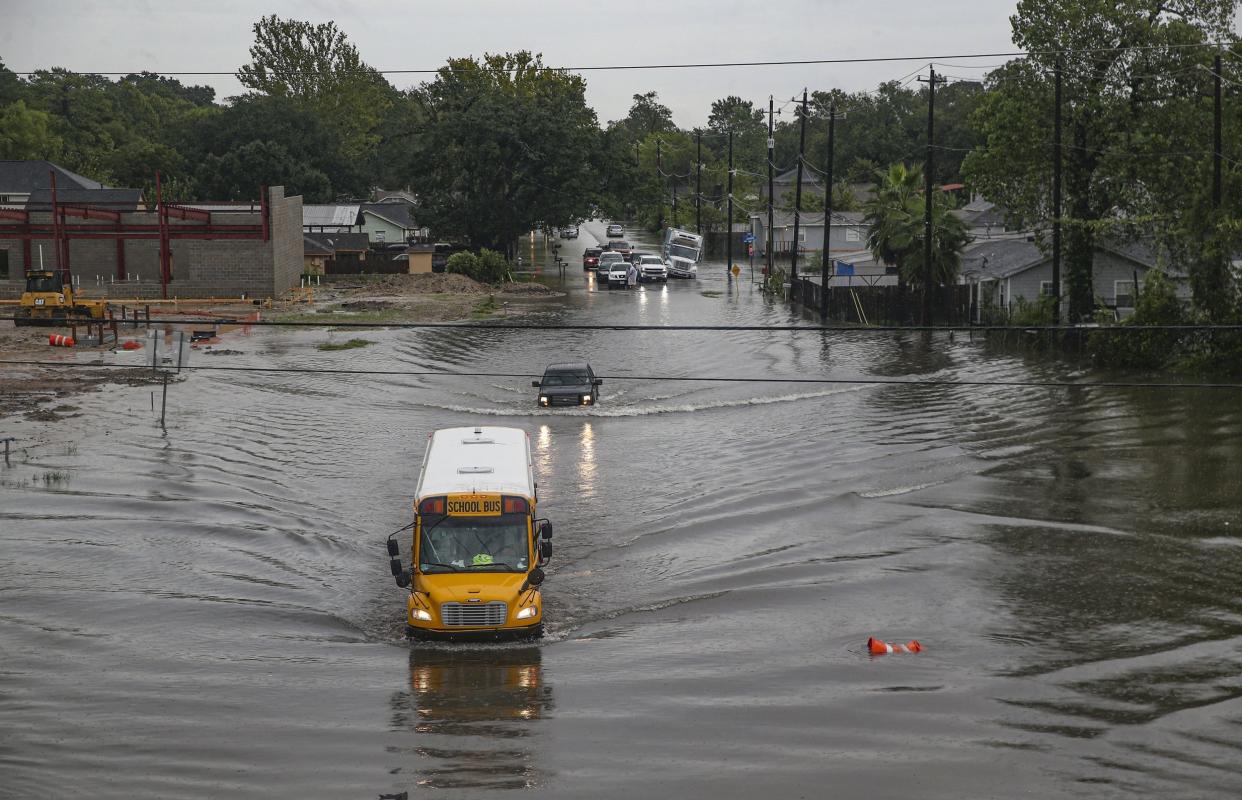Imelda’s toll in Texas: Flooding and fears about a bridge

As the remnants of the former Tropical Storm Imelda moved north on Friday, residents in southeast Texas awoke to shut down roads, scattered thunderstorms and the possibility of more flooding from a storm that became one the top 10 wettest in U.S. history.
The storm that had barely earned a name — it briefly ranked as a tropical storm before being downgraded to a tropical depression — took many residents by surprise with its relentlessness, rekindling memories from when Hurricane Harvey dumped more than 50 inches of rainfall in some areas and caused dozens of deaths in 2017.
As rain trickled down on and off on Friday, residents steeled themselves to assess the damage: At least two people had died, and authorities were investigating a third death after a man last seen walking around during the storm was found dead in a ditch in Houston. Hundreds of homes had been flooded. And thousands were without power Friday morning.
“It’s emotionally draining,” said Rebecca Gay, 41, who had been caring for a friend who was displaced for more than a year after Harvey, before getting stranded again this week. Her friend had not been able to return home to see whether her rebuilt house had survived.
“I don’t want her to see me crying,” Gay said, tearing up. “She’s still got some trauma from Harvey. She’s very fragile. We’re just trying to take it easy and keep it light.”
On Friday morning, officials in the Houston area were scrambling to control barges that broke loose and struck a bridge that carries traffic across the San Jacinto River. Concerned about possible structural damage to the bridge, officials shut down Interstate 10 in both directions.
Houston public schools were closed Friday, but the district was facing a blowback for not canceling classes a day earlier.
As the worst from Imelda blew through on Thursday, parents complained that they were forced to commute in dangerous flooding conditions, even as the mayor was urging people to stay off the roads. They took to the district’s Facebook page to describe chaotic after-school conditions: children wandering the flooded streets, parents wading through thigh-high water with pre-schoolers on their backs, students and administrators sleeping overnight at school. “Total disaster,” one person wrote.
By Friday, roads were still closed, routines were disrupted and people were struggling to get to work across southeast Texas. Some, like Charlotte Kinsey, were sick with worry over missing family members.
Read more
People warned to stay indoors as storm Imelda brings ‘extreme’ floods
Kinsey fled her three-bedroom trailer home in Winnie, Texas, on Thursday afternoon as the floodwaters rose around her and her 3-week-old daughter, Niomi Grace Galley. But she had not heard from her 17-year-old son, Trevor Coffey, who had not been seen since he returned from a job interview late Wednesday. Adding to her concerns, Trevor has a mental health diagnosis that requires medication, she said.
“I don’t know if he’s OK,” she said. “And he can’t swim.”
Even being at the shelter reminded her of Trevor: They had evacuated together to the same shelter in the same event center in Anahuac, Texas, two years ago.
“This is Harvey all over again and we barely made it out the last time,” Kinsey said. “We’re talking about going to my mother’s in Colorado. I can’t do this. I’m not putting my kids through this anymore.”
One possibility emerged late Thursday: A Greyhound bus had been stranded for hours on flooded Interstate 10, and those inside were on the way to the shelter. But it turned out to be a false lead. Trevor was not on the bus.
By Friday morning, still at the shelter, Kinsey said in a text message that her son was still missing.
Much of southeast Texas absorbed more than 10 inches of rain from Tuesday morning to Thursday night. Areas southwest of Beaumont were hit hardest, with an extraordinary 43 inches near Fannett, Texas, enough to make Imelda the seventh wettest tropical cyclone on record in the United States, according to the National Weather Service.
Forecasters predicted scattered and diminished rain on Friday, but warned that any additional rainfall could cause flash flooding in an area already saturated to the extreme.
In a given year, southeast Texas typically sees about 63 inches of rainfall total.
http://players.brightcove.net/624246174001/default_default/index.html?videoId=5837728067001
Support free-thinking journalism and attend Independent events
While climate change tends to increase the amount of rainfall during storms, since a warmer atmosphere can hold more moisture, scientists must evaluate individual storms after the fact to determine how climate change contributed. (Researchers found that the record rainfall during Harvey was as much as 38% higher than would be expected in a world that was not warming.)
In Chambers County on Friday, entire farms were submerged. Fences poked out of the water. Pump jacks and other equipment idled and floated in fields.
“This is brutal,” said Brian Edmonds, who was among three employees of a local landfill standing outside, waiting to see whether they would be called to work.
Nearby, a man driving a sedan stopped before a large pool of water blocking the road. Some cars stopped and turned around, while others drove ahead.
“Trying to get to work,” the man said. “I guess I’ll take a snow day.”
New York Times
Read more
Read more People warned to stay indoors as storm Imelda brings ‘extreme’ floods


